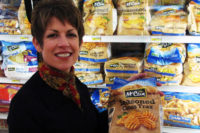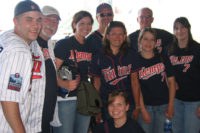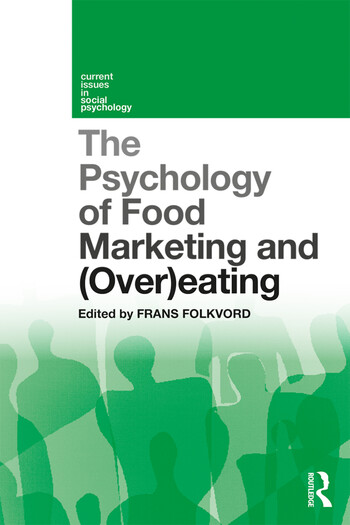Toying Around with New Products
An interview with Bob Eckert

Prepared Foods’ “Food for Thought” feature interview series involves food company R&D professionals, nutritionists, research chefs and other industry executives.
In this third edition, PF Chief Editor Bob Garrison talks with Bob Eckert, the chairman at Mattel Inc.
|
Meet... Experience: Eckert joined Mattel in May 2000 from Kraft Foods, Inc. A 23-year Kraft veteran, he most recently had served as its president and CEO since October 1997. He was responsible for all of Kraft’s business units and for leading the company’s policy decision-making board. Previous positions include serving as group vice president of Kraft Foods, Inc. and being responsible for the company’s Oscar Mayer Foods and North American Foodservice Division, along with the Operations, Sales and Customer Service, Technology, Marketing Services and Business Development staff functions. Eckert joined Kraft Foods in 1977 and held a variety of marketing positions until he was named vice president, strategy and development for Kraft’s Grocery Products Division in 1987, vice president, marketing for Refrigerated Products in 1989, and executive vice president of Kraft Foods and general manager of the Kraft Cheese Division in 1990. Education: B.S., business administration, University of Arizona (1976); M.B.A., marketing and finance, Northwestern University (1977).
|

|
|
PF: What are you up to these days?Eckert: I retired as CEO of Mattel at the end of last year, but I remain chairman of the board. It’s not a full-time position, but it keeps me engaged with the company. I also serve on the boards of McDonald’s and Levi Strauss and Company. So, I’m still involved with iconic brands. But really, I’m playing lots of golf. I took up the game four or five years ago, when my four kids were finished growing up. Now I’m hooked. PF: I remember visiting you at Oscar Mayer’s Madison, Wis., headquarters. Your desk seemed to be filled with Oscar Mayer Wiener Whistles. How many do you own today?Eckert: I’m looking at a Hot Wheels rendition of the Wienermobile that adorns my desk here at Mattel. I’ve also got my honorary Hotdogger name badge, and yes, indeed, I’ve got a Wiener Whistle here. I’ve always had a spot in my heart for the Hotdoggers, the young folks who drive Wienermobiles around the country. They create miles of smiles every day. PF: What’s in your home refrigerator? What are a few of your favorite new foods?Eckert: Just like my mother, I’m pretty loyal to Kraft products. I love Jell-O ready-to-eat pudding. Tastes like mom’s, but no prep needed. And, of course, I’ve got Oscar Mayer lunchmeats, wieners, Claussen pickles and Kraft Singles. Two “newer” foods for me are cranberries (try Post Cranberry Almond Crunch) and McDonald’s southwest salad with grilled chicken. (Be sure to back that up with fries!) PF: We first met in the fall of 1990 when you were executive vice president and general manager of Kraft USA’s Retail Cheese Division. At the time, you spoke about Light Philadelphia Cream Cheese, Kraft Light Natural Reduced Fat Cheese and, the biggest launch, Kraft Light Singles. What new products and trends do you remember from those days?Eckert: The themes of variety, convenience and nutrition were paramount then and, I suspect, remain so today. Oscar Mayer Lunchables, which was created before my time there, remains my all-time favorite food idea. It has the perfect consumer insight: taste and variety for kids coupled with convenience and nutrition for the gatekeeper: mom. PF: What were a few other noteworthy new products during your overall tenure at Oscar Mayer and Kraft?
Eckert: I’m a huge fan of DiGiorno pizza. [Former] Kraft execs Betsy Holden and Mary Kay Haben, still good friends of mine, really propelled DiGiorno to the mainstream. And the positioning, It’s not delivery, it’s DiGiorno., is as relevant today as it was 15 or 20 years ago. I think food marketers broadly, not just at Kraft, are really good at their trade. PF: Any recollections as to why those new items were so successful?Eckert: As in most products, including the toy business, finding the relevant consumer insight is key. For example, one of Mattel’s best performing new products last Christmas was Hot Wheels Wall Tracks. It’s Hot Wheels orange track, which has been around since the late ‘60s that uses 3M adhesive strips that hold it safely on a wall. Kids love the vertical play; moms love getting the toys off the floor. So many homerun ideas are so simple at their core. PF: From what you can observe, how do think the food and beverage new product process or structure has most changed since 2000?Eckert: I’m too far removed to respond directly, but I will say that packaging is an area that I think can still be mined. We use Tide pods at home: detergent plus stain remover plus brightener in one hassle-free, pre-measured capsule. Does it get any easier? I think food packaging has improved (see Oscar Mayer bacon or lunch meats, for example), but other consumer goods categories have done more. Just look at the packaging of Apple products: intimidating, sophisticated electronic gadgets so beautifully displayed. They invite the consumer into the friendly and easy experience of setting them up. PF: Let’s talk about your transition to Mattel and specifically, about that company’s new product development process. What can you tell us about a toy company’s approach to consumer insights?
Eckert: We believe we talk to more kids than anyone else in the world. Some people describe the toy business as “fashion for four-year-olds.” I don’t subscribe to that. The toy business moves very quickly. About 80% of Mattel’s 8,000 SKUs are new every year, but the best ideas are still grounded in consumer insights. PF: What about a toy’s company’s pace of new product development?Eckert: The toy business moves so fast, and it’s part art, part science. The science includes consumer insights, understanding play patterns (for example nurturing or conflict resolution or aspiring to be a teenager), usage occasions (birthday, holiday, gifting) and price points. But the art is apparent in the magic the toy brings to a child. One of the reasons Mattel sells more toys than any other company on the planet—year after year, despite so many of the products being completely new—is that we have the best artisans in the toy business: sculptors, painters, sketch artists, fashion designers, car designers, writers. The other key advantage is the power of our brands, the canvasses, if you will, on which our artists create. Barbie, Hot Wheels, Fisher-Price, American Girl, Thomas and Friends -- I love iconic brands. The toy business understandably works at a frenetic pace. Most toys are purchased during the holiday season. Those products have to be designed, engineered, manufactured overseas, shipped and delivered to retailers by early fall. It’s fun to see the toy development machine, but stressful to experience. PF: How would you describe a toy company’s R&D structure and staffing?Eckert: In toy parlance, it’s “D&D” -- design and development. The structure is identical to the food business: cross-functional teams, including product and packaging designers, engineers, marketing, sales, procurement professionals managing a tight timeline. Unlike the food-heads, however, the toy-heads never outgrew their love of toys. The toy folks have managed to make a living out of something they’ve loved since childhood. In that respect, I think they’re similar to chefs. PF: What were a few of Mattel’s top new products during your tenure there?Eckert: Monster High, Fijit (a five-year-old’s best friend) and Rocky the Robot Truck, just to name a few. Beyond creating brands, however, the key to Mattel’s success is its ability to keep decades old iconic brands fresh and relevant. Barbie, for example, was the best-selling toy 50 years ago as well as during the 2011 holiday season. That’s quite a feat. She’s had more than 125 careers, lots of friends, almost 50 wedding gowns (despite never making it to the altar) and a little bit of work (“plastic never looked so good”). We’ve also been fortunate to develop toys for many other great brands, such as Disney Princess, Pixar CARS, Nickelodeon, Dora the Explorer and WWE. I’ve been a pretty lucky guy. I only worked in two industries, at two companies, both full of fascinating folks. PF: Last question. Let’s pretend you’re addressing a room of food and beverage company R&D executives. In your opinion, where could food companies most learn from toy companies? What’s your advice?Eckert: The biggest difference I found is in speed of decision making. The toy folks need to move quite fast, or they’ll miss Christmas. As a consequence, everyone appreciates the ticking clock and proceeds to get the job done, makes the calls that need to be made, and charges ahead. Food companies have the benefit of time, but I suspect, at times, this actually hurts the process. Be decisive. |
Looking for a reprint of this article?
From high-res PDFs to custom plaques, order your copy today!
 Bob Eckert
Bob Eckert








